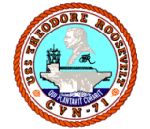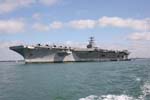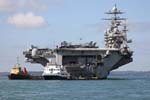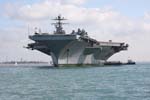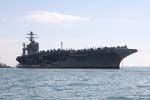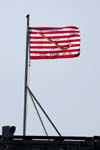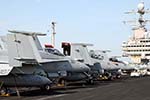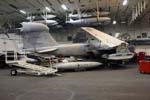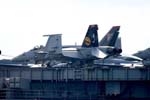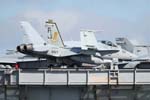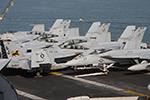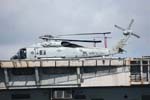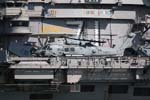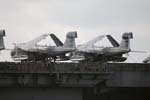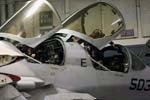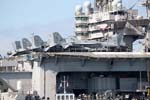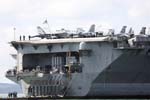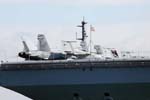Going back a few months into late 2008, Carrier Strike Group Two consisting of the TR and DESRON 22 left their homeports early in September for a regularly scheduled deployment to the Indian Ocean in support of continuing efforts to address maritime issues and reinforce existing relationships. Providing a ring of steel around the carrier, Destroyer Squadron 22 is made up of the Ticonderoga-class guided missile cruiser CG-61 USS Monterey, the Arleigh Burke-class guided missile destroyer DDG-68 USS The Sullivans, the Oscar Austin-class guided missile destroyers DDG-87 USS Mason and DDG-94 USS Nitze, the Improved Los Angeles-class attack submarine SSN-761 USS Springfield and the Supply-class fast combat support ship T-AOE-6 USNS Supply. |
|
|
The air wing, Carrier Air Wing EIGHT (CVW-8), now has a somewhat different look to that of the 2006-cruise air wing. Three years ago, CVW-8 was still equipped with the ever-popular F-14D Tomcats of VF-31 Tomcatters and VF-213 Black Lions in addition to the S-3B Vikings of VS-24 Scouts – though VS-24, their Vikings and the Tomcats have sadly gone, the Tomcatters and Black Lions are still there, albeit re-designated VFA-31 and VFA-213 respectively and equipped with Super Hornets. As such, CVW-8 is currently comprised of the Oceana-based F/A-18E Super Hornets of VFA-31 Tomcatters, F/A-18F Super Hornets of VFA-213 Black Lions, F/A-18C Hornets of VFA-15 Valions and F/A-18A+ Hornets of VFA-87 Golden Warriors. These four strike-fighter units are joined by Whidbey Island-based EA-6B Prowlers of VAQ-141 Shadowhawks, the Jacksonville-based SH-60F / HH-60H Seahawks of HS-3 Tridents and the Norfolk-based E-2C Hawkeyes of VAW-124 Bear Aces and C-2A Greyhounds of VRC-40 Rawhides Det 1. |
What all that means is that the 2008/2009 cruise is somewhat bitter-sweet – on the one hand, after 21 years, VAQ-141 will no longer be flying EA-6Bs from TR’s deck; similarly, HS-3s SH-60F/HH-60Hs have been a fixture of TR flight operations since 1993 and that’s come to an end too. On the other hand it also marks only the second time the Navy’s newest and perhaps most capable strike-fighter, the APG-79 AESA radar equipped F/A-18F, has deployed on a combat cruise. Additionally, it was the first combat cruise for VFA-31 & 213 after swapping the Tomcats for Super Hornets (also referred to as Rhinos). The Block II Super Hornets fielded by the Black Lions, in addition to wielding rather good radars in the shape of the APG-79, are also fitted with a dual-cockpit helmet mounted cueing system. The fancy wizardry of the APG-79 means the air-to-air and air-to-ground modes can be used simultaneously so, for instance, the pilot can deal with an airborne threat whilst the back-seater sorts out the next target on the ground. Add to the dual-cockpit cueing system into the recipe and, in addition to the obvious benefit of both being able to target weapons or slew sensors onto something interesting, the pilot and weapons system officer can see what each other is looking at. Not only does it provide for an additional pair of eyes, it also helps the crew in ensuring they’re both looking at the same target. When there could be forces on the ground being shot at and in need of an accurate placement of 500lb of high explosives, what amounts to a double-check could well be a life saver. |
|
|
As of June 1st 2009, the Tridents of HS-3 not only get re-designated HSC-9 and begin slightly different operations with the new multi-role MH-60S Knighthawks, they’re also moving 600 or so miles north from Jacksonville to Norfolk. In doing so, they will also grow in size so that in addition to operating from the carrier as they would now, they can also provide a two aircraft detachment to other strike group ships such as an underway replenishment ship like USNS Supply, a cruiser like USS Monterey or, alternatively, a conventional land base. As it happens though, three HS-3 HH-60Hs left TR in early January 2008 to forward deploy aboard LPD-17 USS San Antonio and T-AKE-1 USNS Lewis and Clarke to be a small part of Combined Task Force (CTF) 151 set-up to deal with piracy off the coast of Somalia. The detachment returned to their usual home aboard TR about six weeks later having aided in the capture of sixteen pirates. Although their designation and steeds are changing, the Tridents are clearly pretty much already undertaking the type of missions expected of them when they stand-up as HSC-9. |
The Shadowhawks of VAQ-141, on the other hand, from a strictly continuity point of view aren’t quite so lucky and will be transitioning to a vastly different aircraft – the EA-18G Growler. It might be a brand new platform with the latest gadgetry but the role will be pretty much the same as that of Prowler-equipped units… electronic attack. Be that support of air wing strike packages or jamming appropriate regions of the electronic spectrum to thwart insurgents and improvised explosive device usage, no matter how you slice it, it is still airborne electronic attack. Even though the Growler has only two crew positions compared to the Prowler’s four, advanced computer magic and the fact that the pilot can also act as an Electronic Counter Measures Officer (ECMO) like the back-seater, the loss of two ECMOs isn’t an issue from a capability stand point. Using the Super Hornet as a basis does additionally mean the Growler should be better able to keep up with it’s siblings in the strike-fighter squadrons than the Prowler and unlike the Prowler, the Growler can defend itself with AIM-120 missiles. Furthermore, it’s not quite yet in front-line fleet use but already there’s talk of making the electronic warfare suite even more potent in order to better defeat the latest threats. |
|
|
As far as the transition goes, the four Prowlers currently assigned to the Shadowhawks will be re-assigned to other units still operating the aircraft (be that the Fleet Replacement Squadron, VAQ-129 Vikings, or another fleet unit) whilst the personnel are looking at a six month curriculum. VAQ-129, following their own training and certification at NAS Lemoore, is,in addition to remaining as the US Navy and Marine Corps’ sole Prowler training squadron, also responsible for training aircrew in how to fly the Growler. Whilst the aircrew get to stay “home” at Whidbey Island, the maintainers have to attend school at NAS Lemoore where they learn how to perform maintenance and repairs on the new airframe. VAQ-132 Scorpions are currently going through this process to become the first fleet Growler unit and, with eighty-five EA-18Gs ordered, US Navy tactical electronic attack will be entirely on the shoulders of the Growler community by 2014. |
On the way out to the Gulf, TR and most of her strike group went the long way round. That is, rather than going through the Mediterranean and transiting the Suez Canal, the strike group went via South Africa. In doing so, TR and USS Monterey took the opportunity to make a historic visit to Cape Town in October 2008. South Africa are known for their anti-nuclear weapon stance and had previously denied USS Harry S. Truman’s visit back in 2005 when someone realised a US aircraft carrier, though never officially confirmed or denied, would have quite an impressive nuclear arsenal that a number of nations would probably dream of owning – this time, the visit was agreed and TR became the first nuclear powered carrier to visit the country. As it happens, the last aircraft carrier to visit the country was the 45,000t Midway-class CV-42 USS Franklin D. Roosevelt (with CVW-1 embarked) in 1967. Maybe it’s purely coincidence but perhaps the fact that Roosevelt is an anglicized Dutch name has something to do with the South African decision to allow the TR visit?? From South Africa, the strike group sailed up into the Indian Ocean where the group participated in operations with elements of the South African and French navies, consisting of the Valour-class frigate F146 SAS Isandlwana, the fleet replenishment ship A301 SAS Drakensburg, the Warrior-class fast attack craft P1565 SAS Isaac Dyobha and the French Floréal-class frigate F730 FN Floréal. Eventually the strike group made their way into the Arabian Sea and the 5th Fleet area of responsibility. Whilst there, CVW-8 aircraft would be called upon to support Operation ENDURING FREEDOM operations and coalition forces in Afghanistan. |
|
|
Whilst on station in the Arabian Sea, CVW-8 flew in excess of 18,000 hours on more than 3,100 combat sorties in order to provide air support to coalition ground forces in contact with enemy forces in Afghanistan. In doing so, more than 61,000 pounds (or, putting it another way, about 27 tonnes) of precision guided munitions were expended. Considering they were in the region for five months, it doesn’t sound a vast amount when compared to previous deployments but not all sorties would have resulted in weapons release. Munitions of choice included the 500-lb GBU-12 Paveway II LGBs or 500-lb GBU-32 JDAMs in combination with the 20mm rounds from the M61 Vulcan gun. When you can put a 500lb bomb straight onto an enemy position courtesy of laser targeting (either by troops on the ground or by the aircraft itself with an ATFLIR pod) or within a handful of metres thanks to satellite guidance, the end result is pretty much the same, no more enemy and no more risk to coalition forces. It’s probably fair to assume even 500lb would be sufficient to do the job if you go in through the window someone is firing from. On the other hand, a jet providing a simple show of force with the burners lit, rather than doing a spot of industrial scale gardening might very well get the job done. |
However, during those 18,000 hours, not everything went quite as well as would have been hoped for. In February, whilst conducting combat operations, the pilots of two VFA-87 F/A-18A+ Hornets successfully brought their jets back to the carrier following an accident in the vicinity of the carrier which saw their wingtips touch. Thankfully, neither pilot was injured in the incident. It is, however, a testament to their abilities and training that they brought the two jets home. Another incident saw the US Marines at Kandahar get involved; whilst on a combat mission over Afghanistan, a VFA-31 F/A-18E was to take on fuel from a nearby tanker yet during the process, the basket came off the hose and became lodged on the Super Hornet’s probe necessitating a diversion to Kandahar. If the basket had come loose, untold mayhem costing the life of the pilot or, at the very least, lots of dollars, could have ensued. Luck seemingly wasn’t completely on the Tomcatters’ side that day as no-one with Hornet engineering experience was about… a group of HMH-361 Marines, with absolutely no experience of fixed wing aircraft let alone F/A-18Es were, following the green light from VFA-31’s maintenance officer, willing to have a go at fixing the problem. Twenty minutes later, the jet was ready to go although it didn’t leave Kandahar until the following day. Semper Fi??? Semper Paratus, more like. |
|
|
Being in the Persian Gulf for five months and supporting an average of 20 combat sorties a day for five months straight, in addition to the numerous non-combat sorties, isn’t easy on anyone and even more tiring if you imagine working ten hour shifts on a flight deck that offers little shade in temperatures of 40°C plus – as such, the numerous scheduled port visits to Jebel Ali, UAE, would have provided the strike group personnel with much needed breaks and a morale boost... not to mention the obvious positive effect the New England Patriot cheerleader visit would have had on the male personnel! The TR was then relieved by CVN-69 USS Dwight D. Eisenhower (with CVW-7 embarked) and began to head home in late March after offloading stores, equipment and ammunition to IKE. By late March she was in the South Western Approaches and before arriving in The Solent, a number of distinguished visitors were flown out to her aboard a VRC-40 C-2A for an airpower demonstration and reception. At anchor in Stokes Bay for about five days, and after crossing the Atlantic in a spritely eight days, TR sailed into the waters off Mayport, FL, to offload HS-3 and pick up the family members for the Tiger Cruise before finally having the rest of the airwing disembark and then arriving home in Norfolk. In September, almost on her 23rd birthday (from commissioning as a USN ship in October 1986), the Navy is giving her a substantial $3B present – a scheduled 33-month refuelling and complex overhaul – which will help the US Navy to continue speaking softly, whilst carrying a big stick for the next 25 years. |
The author would like to extend many thanks and appreciation to Paul Newman, CAPT Miller, LCDR Kafka, LT Wreski and Kimberly Martin for their help and the crew of CVN-71 USS Theodore Roosevelt for their kind hospitality. |

